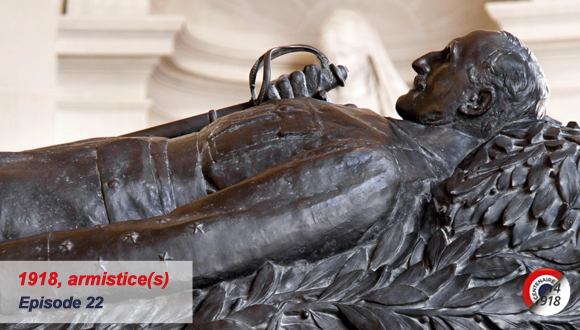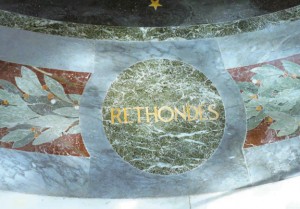 |
 |
Until 10 November 2018, Marshal Foch’s tomb is protected by a scaffolding, and therefore not very visible, due to the restoration of the stained glass windows on Chapelle Saint-Ambroise. © Paris, musée de l’Armée, dist. RMN-GP / Anne-Sylvaine Marre-Noël
 At the end of the ceremony, the coffin containing Foch’s body was placed at the bottom of the steps of the governors’ vault. A large public paraded in front of the vault. The coffin was surrounded by a kepi, a sword, three marshal’s staffs and numerous decorations. © Paris, musée de l’Armée.
At the end of the ceremony, the coffin containing Foch’s body was placed at the bottom of the steps of the governors’ vault. A large public paraded in front of the vault. The coffin was surrounded by a kepi, a sword, three marshal’s staffs and numerous decorations. © Paris, musée de l’Armée.
On the floor, below the head of Foch is the medallion bearing the inscription “Rethondes”. © Paris, musée de l’Armée
The seven stars of the Marshal of France can be seen on the sleeves. © Paris, musée de l’Armée, dist. RMN-GP / Anne-Sylvaine Marre-Noël
Military Necropolis of the Great War
Foch died on 20 March 1929. On 29 March, Parliament passed a law stipulating that “the Marshals of France, the officers-general who, during the war of 1914-1918, exercised either the command-in-chief or the commandment of a group of armies or an army, will be, either on their desire expressed by testamentary disposition, or on request from their successors, buried in the Hôtel des Invalides”. It was immediately applied to Foch.
The Governor’s vault
While waiting for sculptor Paul Landowski (1875-1961) to create the tomb, Foch’s remains were placed in the governors’ cellar from 1929 to 1937.
Marshal Foch’s tomb
The tomb was inaugurated in Saint-Ambroise Chapel on 20 March 1937. On 13 March 1937, a few days before the ash transfer ceremony, Landowski’s work was unveiled in the daily newspaper Le Matin. A week later, on 20 March, the ceremony took place. L’Illustration, a widely-circulated illustrated press review, echoed the event by publishing the same day a double page reproducing the Foch tomb.
The ground, modified when the tomb was set in its new place, offered Landowski the chance form a link with the dome of Les Invalides built by Jules Hardouin-Mansart and Napoleon’s tomb made by Visconti. One of Louis XIV’s monograms, found throughout the dome and particularly on the ground, was modified to render Ferdinand Foch’s two “Fs” intertwined with his French Marshal staff, and set in front of the tomb. The monogram is framed by plants symbolising victory: palm and laurel. Like the pavement around Napoleon’s tomb evoking eight victories of the Napoleonic army, Landowski places around Foch’s tomb a laurel wreath mingled with oak punctuated by eight medallions evoking the First World War and Foch’s actions during that period. The arrangement of the eight medallions does not necessarily follow the chronology of the Great War.




Ajouter un commentaire